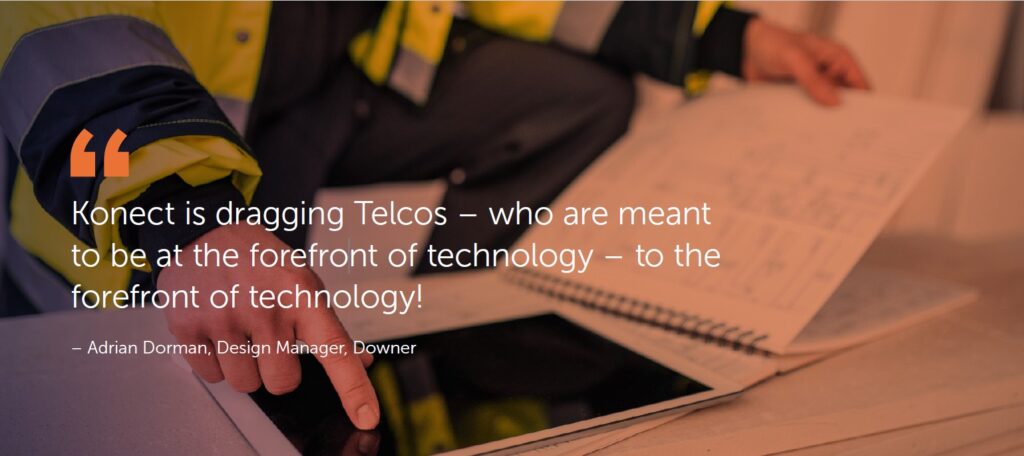
“Konect is dragging Telcos – who are meant to be at the forefront of technology – to the forefront of technology!”
The telecommunications industry has been around in Australia for well over 100 years. With each generation of technological advancement, companies responsible for Telco and its related industries have failed to understand the power of data. In fact, the field engineer with the rolled-up maps and red pen is as prevalent today as it was when pits were dug, and lines laid a century ago.
So, when Downer’s Adrian Dorman took on the design and construction of Australia’s Node to Premise (N2P) evolution and National Broadband Network (NBN) fixed wireless services, he knew that a change was needed. That change, brought about by strategic partner, Tecktrum
Services, was Konect.
Adrian has been involved in Telco design for 27 years, criss-crossing the globe from the UK to the US, and from the Caspian Sea to Australia. Adrian a design team that first introduced FTTC (Fibre To The Curb) technology for NBN into Australia, with the build of the FTTC, affecting 270 thousand premises.
Adrian explained, “I’ve spent a lot of my time in the field pushing the data from Telco’s PNI (Physical Network Inventory): PDFs, photos, paper etc. I realised that it was time to move away from that, and wanted to build my own PNI. I needed a tool that could collect data and feed it into design accurately. I needed a tool that helped the process become streamlined and give everyone involved instant data at their fingertips”.
Despite searching the globe for the right system, it was here, right on his doorstep, that he found it. “I’d previously gone through various systems, including some US ones that didn’t get off the ground. When we saw Konect, we started to see what we could do with it. With Downer, Konect’s automation allowed us to get data and sync it to our databases. For example, the creation of a projects – say 2000 homes – was done in less than a day, and could be used in the field immediately, at very little cost.
Previously, this may have taken up to 15 days to produce maps for a project. Once printed and distributed they would head out in the field and, if errors were noted, the whole process would begin again. Adrian added, “There’s potential for huge complications, especially when splicing a network and, especially if four guys have different versions. With Konect, its always the latest version!”
With over 2000 projects over 14 months, the cost of realising these with paper maps, audit tool, and set up would be in the region of $1.4M. With Konect there’s an automated FME web portal straight into the database using drag and drop. First thing the next day, the guys at Konect push up the notifications. Each one costs $80. For the same project using Konect, that’s a saving of $1.2M!
There will always be those who want the red pen and map back. Change, in any industry, is hard. Adrian has experienced initial reservations, but then down the line they learn to love it. “The visuals are amazing; those in the field don’t get bogged down with unnecessary information.
They get what they want, when they need it. Adrian added, “After a long day in the field, there were often reams of paperwork and recording to do before you went home. With Konect, the job is almost always completed in the field. There’s no more to do.”
For both Downer and Konect, the future looks bright. Adrian concludes, “In the past, the relationships between the planners, strategists, contractors and administrators were impossible to correlate. It was no more than a finger pointing blame game when things went wrong. With Konect we’re working in the right direction together and, when needed, Konect works on the developments we need without delay. From Downers point of view, it is the tool of choice. If it needs geospatial data, every Division will be looking at Konect”.


